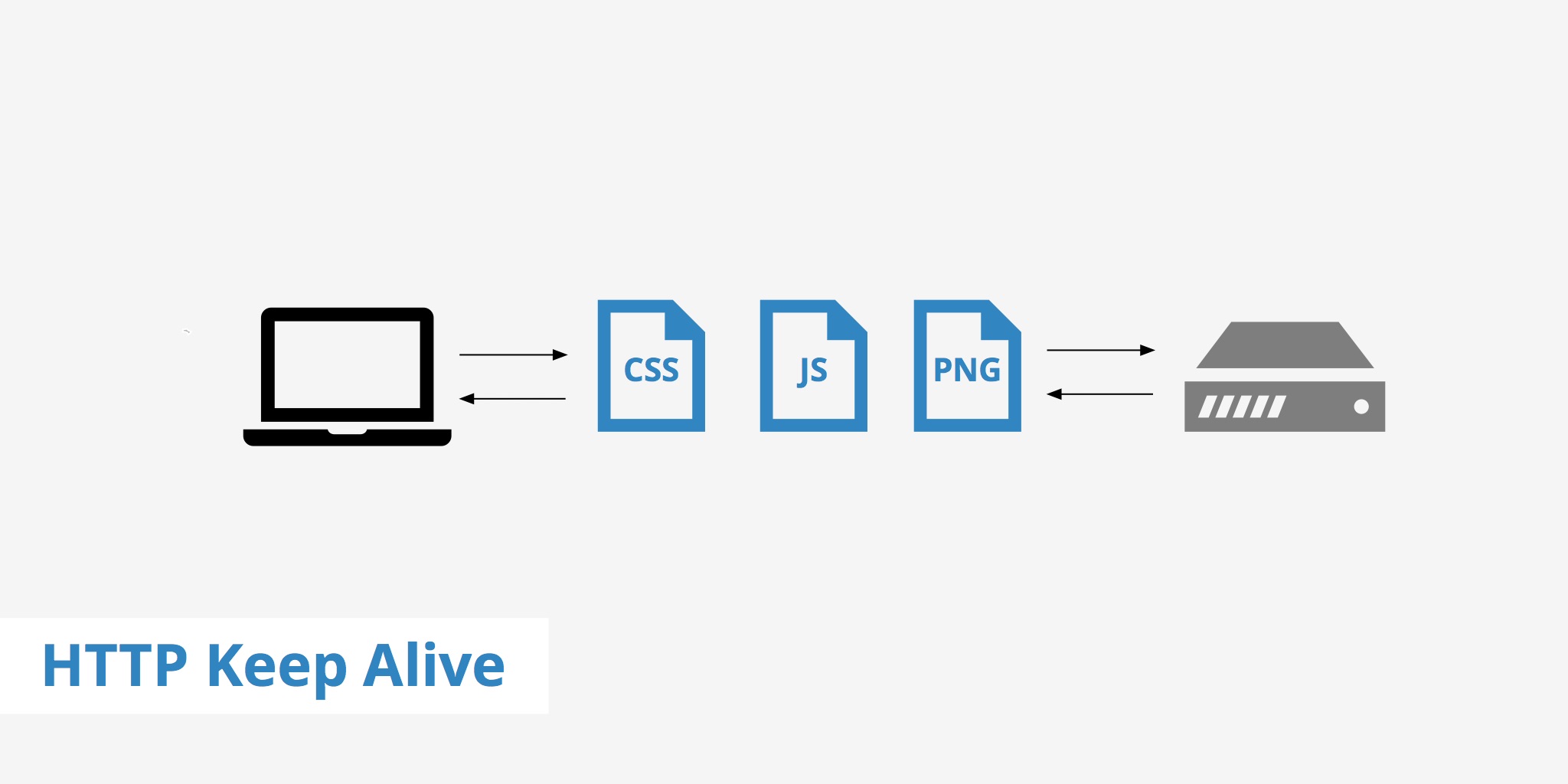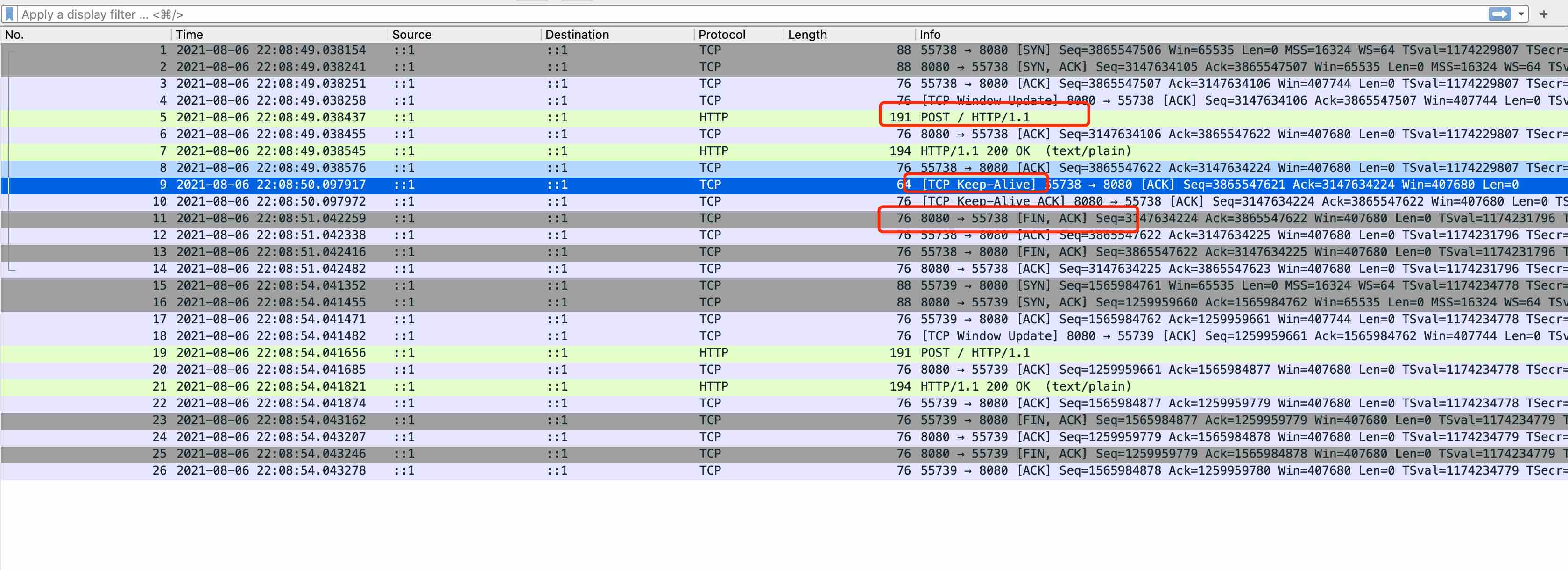如何正确设置连接保活

本文来自十年老粉小六子投稿,内容比较干,大家平时肯定也会遇到
由于线上存在网络问题,会导致 GRPC HOL blocking, 于是决定把 GRPC client改写成 HTTP client
改写 HTTP client 的过程还算顺利,但是搜索日志里面会发现有极少数的 EOF 错误
1 | call xxx failed: Post "http://localhost:8080": EOF |
EOF 这个东西一般是跟 IO 关闭有关系的,Google 了下相关的错误,在 stackoverflow 找到相关的参考
Go by default will send requests with the header Connection: Keep-Alive and persist connections for re-use. The problem that I ran into is that the server is responding with Connection: Keep-Alive in the response header and then immediately closing the connection.
粗略看了下,问题很清晰,就是 server 和 client 的 Keep-Alive 机制的问题,去看下 client 和 serve 的设置参数再去调下应该就可以解决问题
Keep-Alive parameter
HTTP Client
线上在使用的http.Client的参数如下:
1 |
|
Dial中的
DisableKeepAlives为开启状态KeepAlive: 官方文档介绍是一个用于
TCP Keep-Alive的probe指针,间隔一定的时间发送心跳包。每间隔60S进行一次Keep-Alive
1 | type Dialer struct { |
HTTP Server
线上在使用的http server的参数
1 | func main() { |
Server的 KeepAlive 主要是通过 IdleTimeout 来进行控制的,IdleTimeout 如果为空则使用 ReadTimeout
1 | type Server struct { |
Debug again
可以看到,client 侧的 Keep-Alive 是60s,但是 server 侧的时间是间隔10s就去关掉空闲的连接。所以这里很容易就认为是:client 侧的 Keep-Alive 心跳间隔时间太长了,server 侧提前关闭了连接。
于是作出更改:调整 client Keep-Alive 为1s,这个时候感觉就不会出现 EOF 的错误了。
于是修改参数,重新上线,持续观察一段时间发现还是有 EOF 错误。看来只有进行本地复现看看究竟发生了什么
本地复现
Mock EOF
在尝试复现 EOF 错误的时候,看到有 Hijack 这种东西,还是挺好用的。可以看到直接在 server 侧关掉连接, client 侧感知不到连接关闭确实是会有 EOF 错误发生的。
1 | func test(w http.ResponseWriter, r *http.Request) { |
EOF 的原因知道了,在这里应该就是 Server 侧主动关闭了连接,至于为什么关闭连接,可以再继续往下看
Mock Keep-Alive
然后先在本地开始尝试复现 Keep-Alive 的问题,client 侧使用 KeepAlive: time.Second, 每间隔一秒钟的 keep-alive, server 侧同样使用两秒 IdleTimeout: time.Second。
Client 侧代码的 Keep-Alive
1 | func sendRequest(c *http.Client) { |
Server 侧的代码:
1 | func echo(w http.ResponseWriter, r *http.Request) { |
理论上来讲,client间隔一秒发送probe,server的idle为两秒是不会关闭连接的,但是实际却是关闭了旧的连接,重新创建了新的连接。
Server侧输出:
1 | ➜ http-client-server go run http-server-simple.go |
抓包分析
结果有些出乎意料,因为是在本地进行代码复现的,所以去看下抓包分析结果。
 s
s
Client使用的基于TCP层面的Keep-alive协议,针对的是整条TCP连接Server侧明显是基于应用层协议做的判断
所以初步的结论就是两者的 Keep-Alive 是工作在不同层面,让人产生了误解。
源码分析
Client
Client 侧的代码在 net/dial.go 里面,主要进行 Keep-Alive 的逻辑如下
1 | func (d *Dialer) DialContext(ctx context.Context, network, address string) (Conn, error) { |
上面的代码可以看到,最后调用的是 SetsockoptInt,这个函数就不在这具体的展开了,本质上来讲 Client 侧是在TCP 4层让 OS 来帮忙进行的 Keep-Alive。
因为网络的环境是比较复杂的,有很多的请求是跨 LB 进行的,比如 AWS 的 ELB之类的,所以这个 keep-alive 在这里也显得合理。
Server
Server侧的代码在 net/http/server.go里:
1 | func (c *conn) serve(ctx context.Context) { |
简单的说明下, defer 就是关闭连接用的,当函数退出的时候server会关闭连接。
for循坏是处理连接请求用的,可以看出来HTTP server本身其实是不支持处理多个请求的,并没有实现HTTP 1.1协议中的Pipeline。
然后再看keep-alive的操作,先设置ReadDeadline,然后调用c.bufr.Peek这里的调用流程比较长,其实最后会落到conn.Read,本质上是一个阻塞操作。然后开始等待bufr里面的数据,如果client在这个时间段没有发送数据过来,则会退出for循环然后关闭连接
conclusion
所以在上述的场景下想要reuse一个conn主要还是取决于server 侧的idleTimeout。如果没收到client发送的请求是会主动发送fin包进行close的。
如何修复
1.Retry
其实解决方案有很多种,在这里线上采用的是客户端进行重试。这里引申一下,像上面这种错误,如果是GET,HEAD等一些幂等操作的话,client代码库会自动进行重试。我们线上使用的是POST, 所以直接在业务侧进行重试。
2.Increase IdleTimeout
另外一个解决方案就是增加server的IdleTimeout,但是这样一来会消耗更多的server资源。
3.Short-lived conn
还有一种方法就是短连接,这样对server的资源浪费就减轻了,但是不能重用连接。整体latency会受到影响。
小结
写文章不容易,如果对大家有所帮助和启发,请大家帮忙点击在看,点赞,分享 三连
关于 http 超时 大家有什么看法,欢迎留言一起讨论,大牛多留言 ^_^
